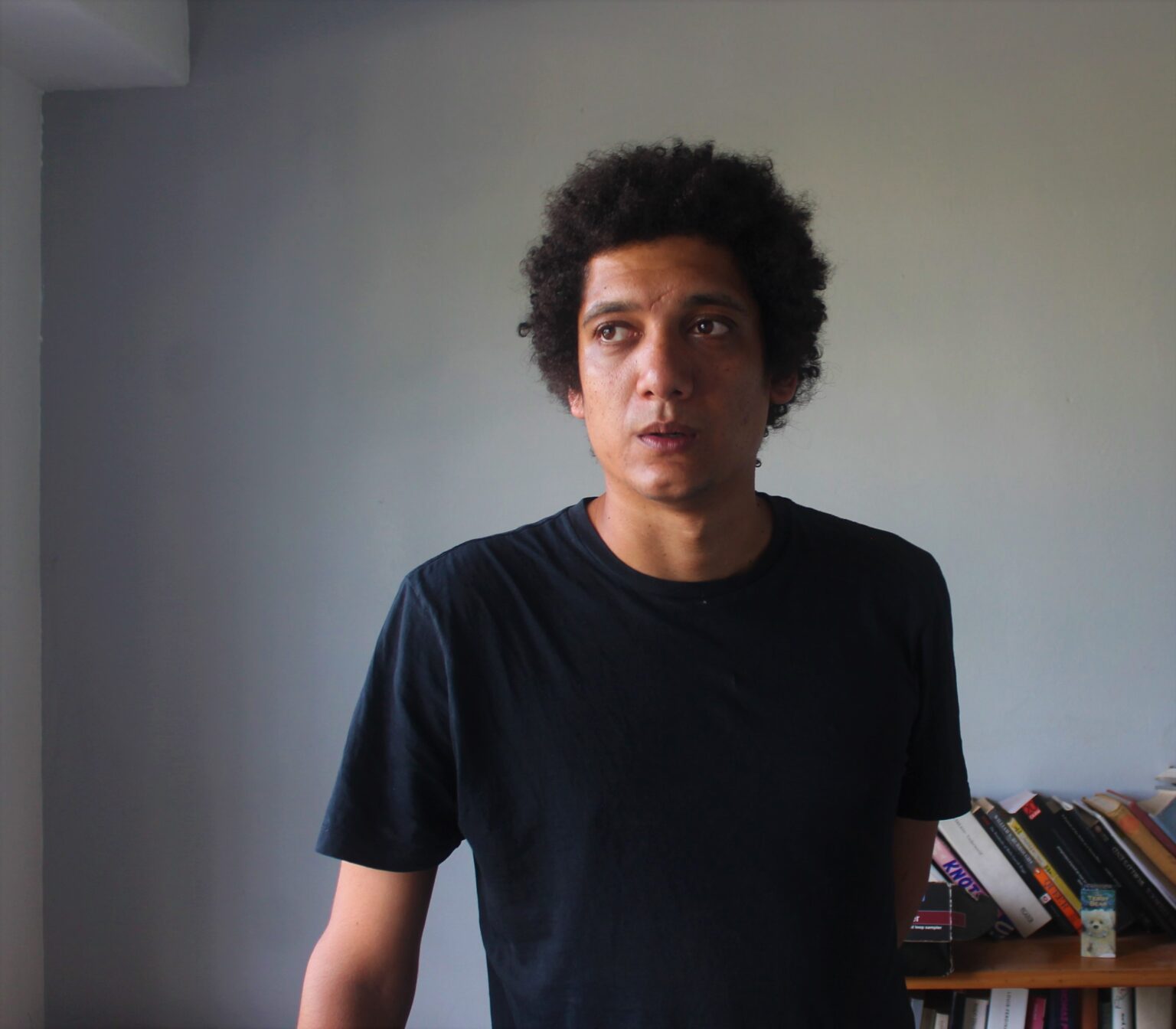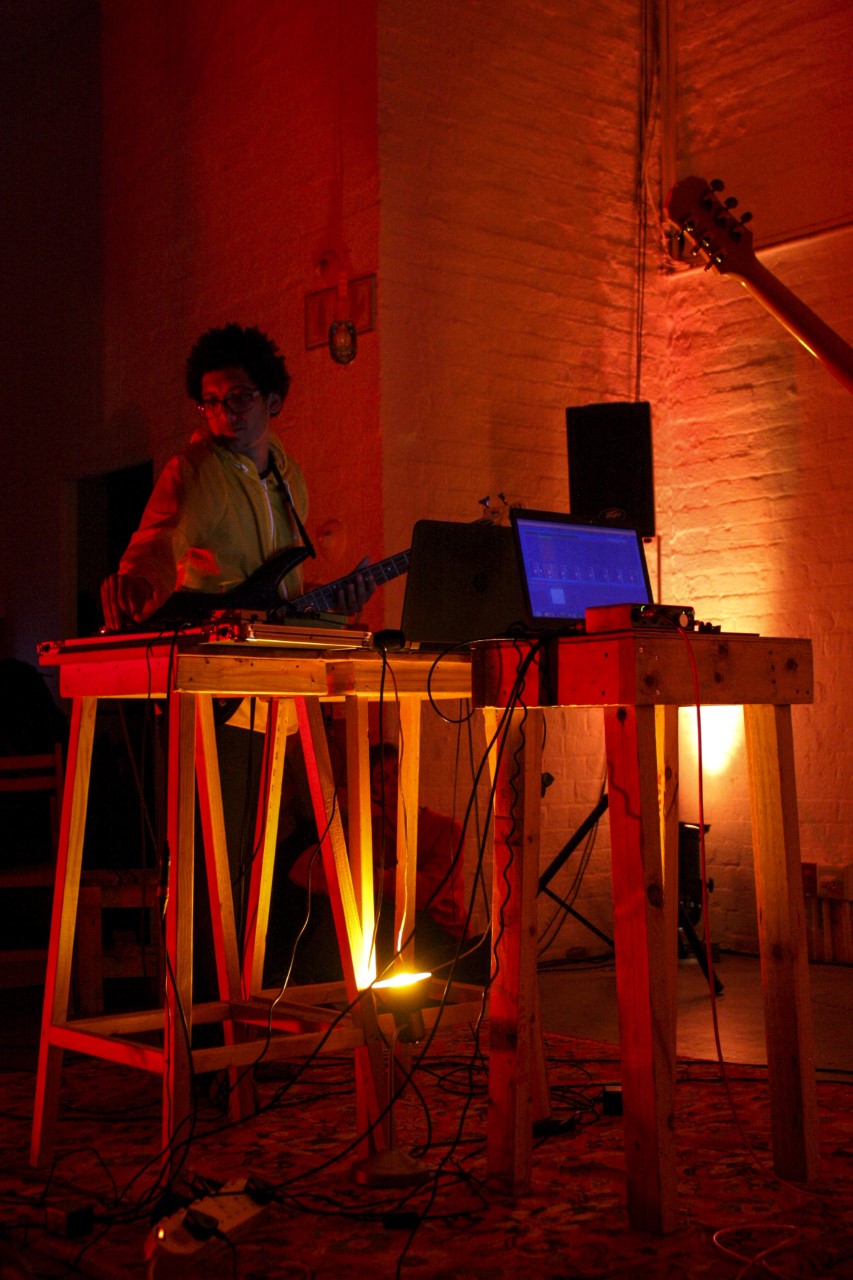When I think of Andrei Van Wyk’s work and practice, I think of colliding and melting-into-each-other sounds, transformed and transforming noise and a notion of “listening beyond what you audibly hear” through his constellation of au/orality. “We need to start thinking about song way beyond its representational qualities within the sonic…” says musician Tumi Mogorosi, and I think of Andrei Van Wyk’s work.
With a focus on hyper textuality, experimental composition, muzak and the relationship between sound, noise and music within the context of human experience, Van Wyk who also produces work under the moniker of Healer Oran, tells the story of social realities moulded by an apocalyptic past, runaway technologies and strange mutations. Like the forehead creases when deep in thought, intensity and tension’s fingerprints can be found littered throughout his work, in the same way that they are all over H/history and politics.
With his practice, Andrei moves away from sound as purely aesthetic to expand on how sound widens historical narratives by incorporating sound collage, plunderphonics and free improvisation to recreate and amplify aspects such as humour, boredom and loss, and to locate them in broader historical narratives.
Below is a digital conversation between me and Andrei about his work, noise, sound au/orality and more.

Lindi Mngxitama: Hi Andrei, can you please start by introducing yourself and your practice(s) to us?
Andrei van Wyk: I’m Andrei van Wyk. In short, I describe myself as a “musician” when introducing myself to others, or someone who tries his best to make music, working in a range of fields including film, dance and performance.
It can be seen as a bit more complicated than that as my practice doesn’t really place much emphasis on a particular field or context such as film or live performance, but rather, it’s focused on whatever “sonic processes” I’m obsessed with at the time, and how I can include it into whatever project I’m working on at that time. Whether scoring for film, working with frequent collaborators like sound artist Daniel Gray or playing in my band The Wretched with Tumi Mogorosi and Gabi Motuba. My practice has a very DIY ethic that I’ve held onto for a very long time, with a focus on making with very little or in states of disarray or disorganisation.
Lindi Mngxitama: Where your creative and artistic sonic practices are concerned you work under the names Andrei Van Wyk and Healer Oran.
Why this distinction in naming yourself in relation to your work? Where, how and why does Andrei Van Wyk begin and end and Healer Oran begin and end — and do they ever meet each other anywhere?
Andrei Van Wyk: The “Healer Oran” moniker began at a tough time in my life, I was in the hospital and not very happy. So its purpose was as a figure disconnected from “Andrei” a little – a way to get confidence to make music again after years of not doing it. I initially began using it with the intention of having some sort of freedom in making, but soon realised that sense of disconnection was really there.
At earlier shows I would jokingly say that “I am trying to be Healer Oran” but soon it took on aesthetics of its own and the processes I worked within for that project are very specific focusing on high pressure frequencies and angular conceptions of rhythm. The choice currently depends on the process that I’m following at that time or the goal that I’m attempting to achieve, whereas previously I used to think of Healer Oran as “dealing with Andrei” in many respects. Now, they’re one and the same and they’re good with each other.
Lindi Mngxitama: Can you tell me more about the research trip to Basel you recently embarked on, what was moving through its interrogative and experimental pulse?
Andrei Van Wyk: Well, the research trip was a couple of years in the making. But my initial engagement was through a conference, linked to my MA studies that I was participating in called, The (in) audible Pasts, having met numerous people who introduced me into Basel a little further — which was intriguing and gave me the opportunity to explore its manner of operation — and where it intersects and deviates from South Africa, or Johannesburg specifically.

Photograph by Zivanai-Matangi
Lindi Mngxitama: Your MA focused on “using sound studies and art as a method to examine narratives of the past with a focus on land dispossession of coloured communities in the Eastern Cape,” something you have researched/engaged with further outside of the context of academia.
As I was thinking about and sitting in mediation with your work for this piece. I started to think about the H/histories of sound and noise themselves, not just thinking about sound and noise as alternate ways to be in relationship with history or to think about it. Environmental historian Peter A. Coates pointed out that what we think of as noise is as much a matter of ideology as it is of decibels.
If we think about sound and noise beyond the aesthetic, would you say the distinction between the two and the processes of distinction that have set them apart are also political/politicised? Why is something considered noise and something else sound?
Andrei Van Wyk: Within my research, ‘noise’, ‘rhythm’ and ‘sound’ are all incredibly politicised and within the study of H/history, they signify the racialised and gendered divisions of labour within the social conditions that we currently live in. The research focuses greatly on how these social relations occur and operate within the greater societal ‘soundscape’, with a particular focus on South Africa.
My research does tend to treat sounds within the boundaries and limitations of au/orality, the politics of listening and orating, how the sonic engages with different bodies, and how societal structure curates the manner in which the sonic is broadcast and perceived.
In terms of your reference to Coates, like how ‘decibels’ are quantified and become a measurable means of noise, that logic has been placed on people or societal structures, and how they are controlled. Placing that logic onto people of varying identities influences the operation of their subjectivities.
Lindi Mngxitama: What has your sonic practice; sound, noise; sounds of violence and the processes of transformation you take them through as a modality of healing unearthed to you about histories of displacement and dispossession, particularly in relation to South Africa?
Andrei Van Wyk: My practice has become more complex, and I embraced the fact that — like the nature of the sonic — the historical social conditions remain quite unresolved.
What sound shows me when investigating past narratives, is that concepts such as dispossession are ongoing and do not remain static. My practice seeks to treat the ‘soundscape’ as a stage where these narratives can be reproduced [through] further interrogation.
This story is produced in the context of an editorial residency supported by Pro Helvetia Johannesburg, the Swiss Arts Council.

Photograph by Skye Quadling



















































